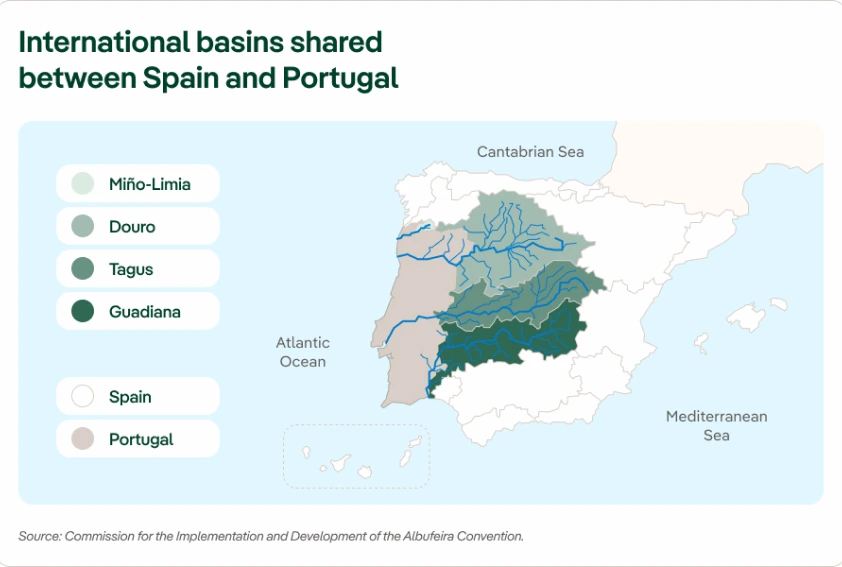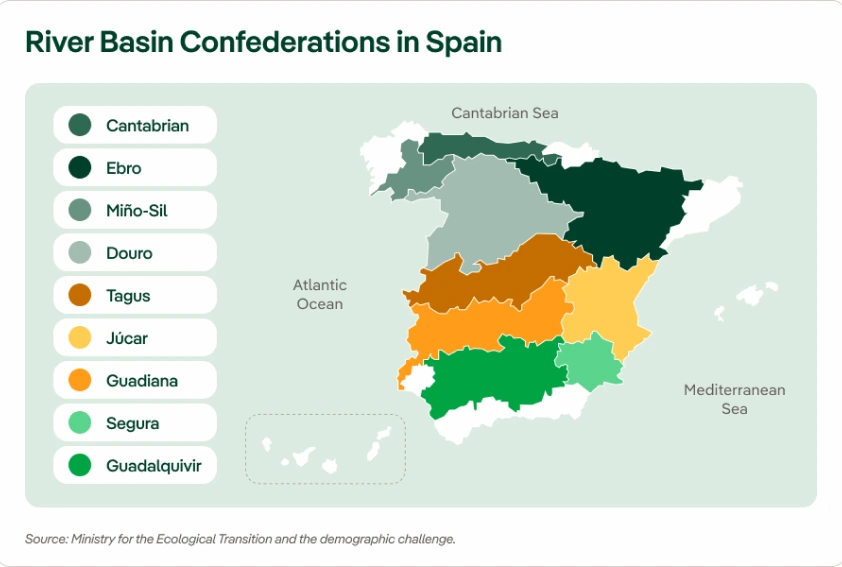ALBUFEIRA CONVENTION
Management and agreements in the shared river basins of Spain and Portugal: The Albufeira Convention
Spain and Portugal share the Miño, Limia, Duero, Tagus and Guadiana river basins. For this reason, coordination between the two countries is necessary not only to manage the use of shared waters, but also to jointly face the challenges of climate change from an environmental perspective.

Cedillo hydropower plant and dam, on the Tagus river, Spain-Portugal border
November 2023 marked the 25th anniversary of the Albufeira Convention signing for protecting waters and the sustainable use of shared river basins in Spain and Portugal. On this page, we explain what the Albufeira Convention is, and its impact on Spain and its river basins.
What is the Albufeira Convention?
The Convention on Cooperation for the Protection and Sustainable Use of the Waters of the Spanish-Portuguese Hydrographic Basins, known as the Convenio de Albufeira (Albufeira Convention), due to its signing in the Portuguese town, is an instrument of cross-border cooperation between Spain and Portugal – a reference in the planning and management of Portuguese-Spanish water resources. It was signed on 30 November 1998 by both countries, within the framework of the 15th Portuguese-Spanish Summit, to coordinate the administration and use of the waters that these five river basins share: Minho, Limia, Douro, Tagus and Guadiana.
This alliance is established to coordinate the necessary actions between the two countries to promote and protect the good status of surface and groundwater, to carry out sustainable water use and to mitigate the effects of floods, droughts or scarcity, which are becoming increasingly frequent and extreme due to climate change. To this end, the agreement establishes the framework to define the necessary flow regime to ensure good water status and uses, both current and future, of the catchment areas of the rivers involved.
The Convention entered into force on 17 January 2000 – a period of numerous meetings with working groups and the Commission for the Application and Development of the Convention (CADC). In this way, there is a permanent dialogue between the Administrations responsible for water management in both countries, which participate proactively in the collaboration mechanisms established by the Convention.
The agreement was revised in April 2008 with the main purpose of improving the flow regime, taking into account not only geographical, hydrological and climatic criteria of the basins, but also the water needs to ensure their good status.
What are the implications of the Albufeira Convention for Spain?
The protection purposes of the Albufeira Convention cover both surface waters and groundwaters, as well as the aquatic and terrestrial ecosystems that directly depend on them. Thanks to this agreement, each State will manage its water systems to ensure a minimum flow in certain sections of rivers, called 'flow regime monitoring stations'. Flows are set for annual, quarterly and weekly periods, except for 'exception periods' which are also covered by the Convention. These exception periods refer to situations of low rainfall compared to the historical average. In addition, the agreement highlights a protocol for sharing hydrometeorological data in real time, together with monthly monitoring of the shared river basins.
Iberdrola España has dams and hydroelectric power plants in the Douro and Tagus basins, some of them located on the border between Spain and Portugal. This means that Iberdrola must ensure the delivery of the water volume agreed, both in the Tagus (Cedillo waterfall) and in the Douro (Saucelle waterfall). Thus, Spain must deliver annual, quarterly and weekly volumes. The volumes to be delivered on a quarterly basis change throughout the year, adjusting to the seasonal variability of rainfalls.
What are international river basins?
River basins, as defined in the Water Framework Directive (WFD), are areas of land whose surface runoff flows in its entirety through a series of streams, rivers and lakes to the sea via a single mouth, estuary or delta. These areas are considered indivisible and include transitional and coastal waters. International river basins are basins where waters flow across two or more countries, so that the courses of the rivers, streams and tributaries that are part of these basins cross several countries. Therefore, since the water in these basins is shared, their management involves a cooperative approach between the countries involved to manage water resources in a sustainable and equitable way.
Basin organisations, known in Spanish as Confederaciones Hidrográficas (River Basin Confederations), are the entities in charge of the river basins in Spain and are responsible for water management in the basins. Thus, they play a fundamental role in hydrological planning, administration and control of public waters and uses, concession of private water use rights, design and development of new hydraulic infrastructures, control of the water’s status and quality, among other things.
What are the international basins in Spain?
Among the main international basins in Spain are those linked to the Albufeira Convention.
-
Miño-Limia River Basin. In February 2007 the territorial scope of the Hydrographic Demarcations was defined, and in the scope of action of the North River Basin Confederation, the Miño-Limia and North River Basin Confederation were included. In 2008, with the creation of the Miño-Sil River Basin Confederation, the Hydrographic Demarcation of this River Basin Organisation was renamed Miño-Sil, whose Spanish part covers 7 provinces, belonging to Galicia, Castile and Leon and Asturias, with a total area of 17,582 km². Flow delivery is controlled in a single section, the Frieira waterfall.
-
Douro River Basin. The international Douro river basin demarcation is the largest in the Iberian Peninsula with 98,073 km2, including the territory of the Douro river basin and also the transitional waters of the Porto estuary and the associated Atlantic coastal waters. It is a shared territory between Portugal (20% of the total area) and Spain (80%). The Spanish part of the demarcation covers 78,859 km2, and the Douro river itself serves as a border between the two countries for 100 km. In this sense, flow delivery to Portugal is controlled in four sections: the Miranda dam, the Bemposta dam, the Saucelle reservoir and the hydrometric station of the Águeda river, and the Crestuma dam.
-
Guadiana River Basin. The international river basin of the Guadiana River, shared between Spain and Portugal, has a total surface area of 67,129 km². The Spanish area comprises 55,508 km² of it and the Portuguese part, 11,621 km². In order to control the delivery of flows to Portugal, two specific points are monitored: the Badajoz weir and the Pomarão hydrometric station.
-
Tagus River Basin. The Tagus river basin extends over the territories of Spain and Portugal and is located in the central area of the Iberian Peninsula. It has an elongated shape and runs from east to west. This basin covers an area of 81,447 km², of which 68% corresponds to Spanish territory and 32% to Portuguese territory. Flow delivery is controlled in two sections: the Cedillo waterfall and the Ponte de Muge hydrometric station.

What are the River Basin Confederations in Spain?
Spain was a pioneer in water management through river basins, a model that, over time, has been adopted by various countries. Thus, the Hydrographic Confederations, known in Spanish as Confederaciones Sindicales Hidrográficas (CSH), were created in Spain by the Royal Decree of 5 March 1926. The first to be approved was the Confederación Sindical Hidrográfica del Ebro, by another Royal Decree of the same date. Throughout that decade, the remaining hydrographic confederations were created.
Currently, there are 9 inter-community basin organisations (river basins that exceed the territorial scope of an Autonomous Community [Region]), called Confederaciones Hidrográficas (River Basin Confederations), and are attached to the Ministry for Ecological Transition and the Demographic Challenge. There are also 12 management areas in intra-community basins (river basins that do not exceed the territorial scope of an Autonomous Community]), which are the responsibility of the Autonomous Community water administrations.





